Integrin alpha L
Integrin, alpha L (antigen CD11A (p180), lymphocyte function-associated antigen 1; alpha polypeptide),also known asITGAL,is a protein that in humans is encoded by theITGALgene.[5]CD11a functions in the immune system. It is involved in cellular adhesion and costimulatory signaling. It is the target of the drugefalizumab.
Function[edit]
ITGALgene encodes the integrin alpha L chain. Integrins are heterodimeric integral membrane proteins composed of an alpha chain and a beta chain. This I-domain containing alpha integrin combines with the beta 2 chain (ITGB2) to form the integrin lymphocyte function-associated antigen-1 (LFA-1), which is expressed in all leukocytes. LFA-1 plays a central role in leukocyte intercellular adhesion through interactions with its ligands, ICAMs 1-3 (intercellular adhesion molecules 1 through 3), and also functions in lymphocyte costimulatory signaling.[6]
CD11a is one of the two components, along withCD18,which formlymphocyte function-associated antigen-1.
Efalizumabacts as animmunosuppressantby binding to CD11a but was withdrawn in 2009 because it was associated with severe side effects.
Interactions[edit]
CD11a has been shown tointeractwithICAM-1.[7][8][9]
See also[edit]
References[edit]
- ^abcGRCh38: Ensembl release 89: ENSG00000005844–Ensembl,May 2017
- ^abcGRCm38: Ensembl release 89: ENSMUSG00000030830–Ensembl,May 2017
- ^"Human PubMed Reference:".National Center for Biotechnology Information, U.S. National Library of Medicine.
- ^"Mouse PubMed Reference:".National Center for Biotechnology Information, U.S. National Library of Medicine.
- ^"NCBI".
- ^"Entrez Gene: ITGAL integrin, alpha L (antigen CD11A (p180), lymphocyte function-associated antigen 1; alpha polypeptide)".
- ^Lu C, Takagi J, Springer TA (May 2001)."Association of the membrane proximal regions of the alpha and beta subunit cytoplasmic domains constrains an integrin in the inactive state".J. Biol. Chem.276(18): 14642–8.doi:10.1074/jbc.M100600200.PMID11279101.
- ^Shimaoka M, Xiao T, Liu JH, Yang Y, Dong Y, Jun CD, McCormack A, Zhang R, Joachimiak A, Takagi J, Wang JH, Springer TA (Jan 2003)."Structures of the alpha L I domain and its complex with ICAM-1 reveal a shape-shifting pathway for integrin regulation".Cell.112(1): 99–111.doi:10.1016/S0092-8674(02)01257-6.PMC4372089.PMID12526797.
- ^Yusuf-Makagiansar H, Makagiansar IT, Hu Y, Siahaan TJ (Dec 2001). "Synergistic inhibitory activity of alpha- and beta-LFA-1 peptides on LFA-1/ICAM-1 interaction".Peptides.22(12): 1955–62.doi:10.1016/S0196-9781(01)00546-0.PMID11786177.S2CID54343441.
Further reading[edit]
- Lub M, van Kooyk Y, Figdor CG (1995). "Ins and outs of LFA-1".Immunol. Today.16(10): 479–83.doi:10.1016/0167-5699(95)80031-X.PMID7576051.
- Dickeson SK, Santoro SA (1998)."Ligand recognition by the I domain-containing integrins".Cell. Mol. Life Sci.54(6): 556–66.doi:10.1007/s000180050184.PMC11147323.PMID9676575.S2CID9775686.
- Porter JC, Hogg N (1999). "Integrins take partners: cross-talk between integrins and other membrane receptors".Trends Cell Biol.8(10): 390–6.doi:10.1016/S0962-8924(98)01344-0.PMID9789327.
- Giblin PA, Lemieux RM (2006). "LFA-1 as a key regulator of immune function: approaches toward the development of LFA-1-based therapeutics".Curr. Pharm. Des.12(22): 2771–95.doi:10.2174/138161206777947731.PMID16918410.
- Maurer D, Holter W, Majdic O, Fischer GF, Knapp W (1991). "CD27 expression by a distinct subpopulation of human B lymphocytes".Eur. J. Immunol.20(12): 2679–84.doi:10.1002/eji.1830201223.PMID1702722.S2CID9794163.
- Kalter DC,Gendelman HE,Meltzer MS (1992). "Inhibition of human immunodeficiency virus infection in monocytes by monoclonal antibodies against leukocyte adhesion molecules".Immunol. Lett.30(2): 219–27.doi:10.1016/0165-2478(91)90029-A.PMID1757107.
- Alvarez V, Pulido R, Campanero MR, Paraiso V, de Landázuri MO, Sánchez-Madrid F (1992)."Differentially regulated cell surface expression of leukocyte adhesion receptors on neutrophils".Kidney Int.40(5): 899–905.doi:10.1038/ki.1991.291.PMID1762294.
- Valentin A, Lundin K, Patarroyo M, Asjö B (1990)."The leukocyte adhesion glycoprotein CD18 participates in HIV-1-induced syncytia formation in monocytoid and T cells".J. Immunol.144(3): 934–7.doi:10.4049/jimmunol.144.3.934.PMID1967280.
- Larson RS, Corbi AL, Berman L, Springer T (1989)."Primary structure of the leukocyte function-associated molecule-1 alpha subunit: an integrin with an embedded domain defining a protein superfamily".J. Cell Biol.108(2): 703–12.doi:10.1083/jcb.108.2.703.PMC2115430.PMID2537322.
- Hildreth JE, Orentas RJ (1989). "Involvement of a leukocyte adhesion receptor (LFA-1) in HIV-induced syncytium formation".Science.244(4908): 1075–8.Bibcode:1989Sci...244.1075H.doi:10.1126/science.2543075.PMID2543075.
- Sanders ME, Makgoba MW, Sharrow SO, Stephany D, Springer TA, Young HA, Shaw S (1988)."Human memory T lymphocytes express increased levels of three cell adhesion molecules (LFA-3, CD2, and LFA-1) and three other molecules (UCHL1, CDw29, and Pgp-1) and have enhanced IFN-gamma production".J. Immunol.140(5): 1401–7.doi:10.4049/jimmunol.140.5.1401.PMID2894392.
- Corbi AL, Larson RS, Kishimoto TK, Springer TA, Morton CC (1988)."Chromosomal location of the genes encoding the leukocyte adhesion receptors LFA-1, Mac-1 and p150,95. Identification of a gene cluster involved in cell adhesion".J. Exp. Med.167(5): 1597–607.doi:10.1084/jem.167.5.1597.PMC2188934.PMID3284962.
- te Velde AA, Keizer GD, Figdor CG (1987)."Differential function of LFA-1 family molecules (CD11 and CD18) in adhesion of human monocytes to melanoma and endothelial cells".Immunology.61(3): 261–7.PMC1453405.PMID3301632.
- Qu A, Leahy DJ (1995)."Crystal structure of the I-domain from the CD11a/CD18 (LFA-1, alpha L beta 2) integrin".Proc. Natl. Acad. Sci. U.S.A.92(22): 10277–81.Bibcode:1995PNAS...9210277Q.doi:10.1073/pnas.92.22.10277.PMC40779.PMID7479767.
- Turner ML, McIlwaine K, Anthony RS, Parker AC (1995). "Differential expression of cell adhesion molecules by human hematopoietic progenitor cells from bone marrow and mobilized adult peripheral blood".Stem Cells.13(3): 311–6.doi:10.1002/stem.5530130312.PMID7542116.S2CID21373771.
- Marzusch K, Ruck P, Geiselhart A, Handgretinger R, Dietl JA, Kaiserling E, Horny HP, Vince G, Redman CW (1993). "Distribution of cell adhesion molecules on CD56++, CD3-, CD16- large granular lymphocytes and endothelial cells in first-trimester human decidua".Hum. Reprod.8(8): 1203–8.doi:10.1093/oxfordjournals.humrep.a138229.PMID7691868.
- Capobianchi MR, Ameglio F, Cordiali Fei P, Castilletti C, Mercuri F, Fais S, Dianzani F (1994). "Coordinate induction of interferon alpha and gamma by recombinant HIV-1 glycoprotein 120".AIDS Res. Hum. Retroviruses.9(10): 957–62.doi:10.1089/aid.1993.9.957.PMID7904170.
- Berman PW, Nakamura GR (1994). "Adhesion mediated by intercellular adhesion molecule 1 attenuates the potency of antibodies that block HIV-1 gp160-dependent syncytium formation".AIDS Res. Hum. Retroviruses.10(5): 585–93.doi:10.1089/aid.1994.10.585.PMID7917519.
- Chirmule N, Oyaizu N, Saxinger C, Pahwa S (1994)."Nef protein of HIV-1 has B-cell stimulatory activity".AIDS.8(6): 733–4.doi:10.1097/00002030-199406000-00002.PMID8086129.S2CID36774740.
External links[edit]
- CD11a+Antigenat the U.S. National Library of MedicineMedical Subject Headings(MeSH)
- ITGALInfo with links in theCell Migration GatewayArchived2014-12-11 at theWayback Machine
- HumanITGALgenome location andITGALgene details page in theUCSC Genome Browser.

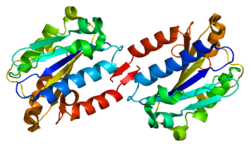






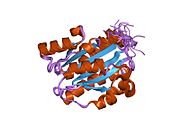
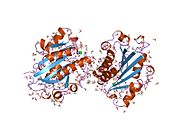

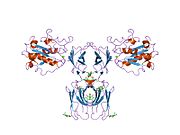
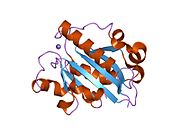
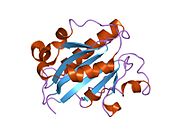

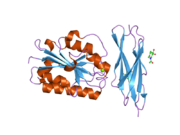
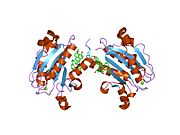
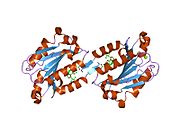
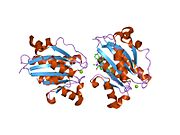


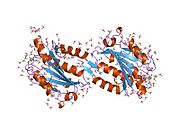
![2ica: CD11a (LFA1) I-domain complexed with BMS-587101 aka 5-[(5S, 9R)-9-(4-cyanophenyl)-3-(3,5-dichlorophenyl)-1-methyl-2,4-dioxo-1,3,7-triazaspiro [4.4]non-7-yl]methyl]-3-thiophenecarboxylicacid](https://upload.wikimedia.org/wikipedia/commons/thumb/a/a2/PDB_2ica_EBI.jpg/180px-PDB_2ica_EBI.jpg)
![2o7n: CD11A (LFA1) I-domain complexed with 7A-[(4-cyanophenyl)methyl]-6-(3,5-dichlorophenyl)-5-oxo-2,3,5,7A-tetrahydro-1H-pyrrolo[1,2-A]pyrrole-7-carbonitrile](https://upload.wikimedia.org/wikipedia/commons/thumb/f/f8/PDB_2o7n_EBI.jpg/180px-PDB_2o7n_EBI.jpg)